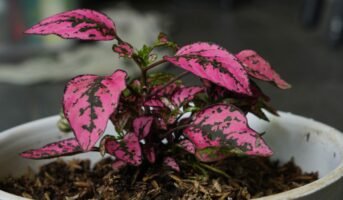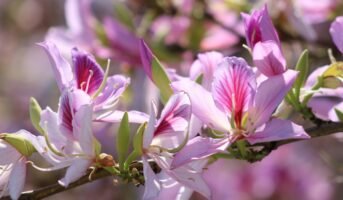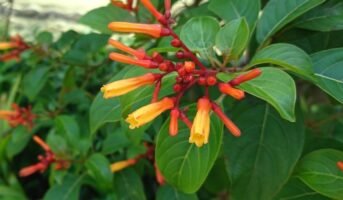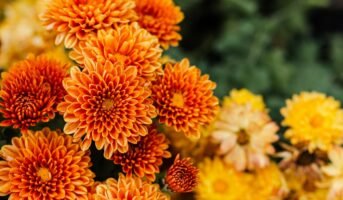Graptophyllum pictum, or the caricature plant, is a flowering shrub that is popular as foliage. This plant belongs to the family of Acanthaceae, which encapsulates hundreds of species. Graptophyllum pictum is native to New Guinea but is also grown in all other countries of the world. These plants are grown for their beautiful leaves and evergreen nature.

Source: Pinterest
Graptophyllum pictum comes in two varieties. One variety has variegated or bicolour leaves and is known as ‘white adulsa’. There is also a dark-leaved variety that is called ‘black adulsa’ in India. These plants can reach upto 60 inches when kept for a long time. They have a tendency to spread out and become bushy. On mature plants, the leaves are much longer, and the bicolour is more visible. The plant also produced purple, tubular flowers during its blooming season.
Graptophyllum pictum: Key facts
| Name | Graptophyllum pictum |
| Common name | Tricolor Caricature Plant, Waimea Caricature Plant, Black Adulsa |
| Type | Shrub, evergreen |
| Origin | New Guinea |
| Indoor/Outdoor | Outdoor |
| Soil | Loamy and well-drained |
| Temperature | 28-32°C |
| Water | Regular |
| Sunlight | Full sun |
| Fertiliser | Compost |
Graptophyllum pictum: Growing tips
- Both full sun and full shade are appropriate growing conditions for a caricature plant.
- Sunlight usually produces a darker, richer foliage colour, but requires more water.
- Regularly water your caricature plant. It does not tolerate drought well, unlike many common tropical landscape shrubs.
- You should water your plants about an inch a week, either through rainfall or irrigation.
- The caricature plant can be pruned whenever it grows out of bounds.
- When you grow caricature plants in the landscape, you typically do not need to fertilise them, but they will grow faster if you do.
- You should fertilise it regularly when it’s in a pot if you want it to thrive.
Graptophyllum pictum: Care tips
Graptophyllum pictum is mostly kept in gardens for its ornamental value. This plant has great foliage and sprouts beautiful leaves. It is similar to coleus and needs more or less the same type of care. If you are thinking about owning a Graptophyllum pictum, here are some tips that will help you grow them well.

Source: Pinterest
Soil
Graptophyllum pictum grows best in loamy and nutrient-rich soil. It can grow in sandy and clayey soil, but it won’t grow as rapidly or as healthy. It also needs well-drained soil to avoid root rot. If water accumulates near the roots for long periods, the plant will die. In case you decide to pot it, use a perforated pot for drainage.
Water
Graptophyllum pictum needs adequate water to grow, just like any other plant. Watering it every other day will be the ideal way to go. The best way would be to check the topsoil to see if it’s dry. If the soil looks dry and cracked, water it immediately. Increase the gap between watering during the rainy and winter seasons.
Sunlight
Graptophyllum pictum needs plenty of sunlight to grow. It can tolerate semi-shade, but the plant won’t grow that well. For a bushy and healthy plant, you need to grow it in full sunlight.
Graptophyllum pictum: Benefits
Graptophyllum pictum is a popular plant that is also used in folk medicine. Additionally, in India, it has been used in Ayurveda to find cures for various illnesses. Extracts from Graptophyllum pictum are edible and safe for the body. They are useful for their laxative, antibacterial, and anti-inflammatory properties. The plant helps patients suffering from migraines, ear problems, cough and cold, etc.

Source: Pinterest
Here are some of the top medicinal benefits of Graptophyllum pictum:-
Cures hand ulcers
Graptophyllum pictum extracts are known to have certain medicinal properties that help cure ulcers of the hands. They are also used in medical research to find a permanent cure for ulcers.
Treats wounds
Graptophyllum pictum is a plant that is known for its antibacterial and antimicrobial properties. Extracts from the plant are used to treat open wounds and bruises that can be tough to deal with. It inhibits the growth of bacteria and prevents infection of the affected area.
Soothes earaches
The plant is also known to be the ultimate cure for many diseases related to the ears. It can cure earaches and relieve pain. Extracts from the plant are poured directly into the affected ear for instant relief from pain. This technique has been practised in folk medicine and ancient Ayurveda.
Cures constipation
Graptophyllum pictum has laxative properties that are known for clearing the stomach. It helps relieve constipation by naturally promoting the movement of body waste. It can be consumed directly to help with problems of constipation.
Relieves pain and headache
The plant has strong anti-inflammatory property that helps it deal with pain and swelling. It also reduces stress and relieves headaches in patients suffering from migraines.
FAQs
What is the common name of Graptophyllum pictum?
Tricolor Caricature Plant, Waimea Caricature Plant, and Black Adulsa are some of the common names of the plant.
How do you care for Graptophyllum?
The plant grows best in soils that are rich in organic matter, medium in moisture, and well-drained. Although plants can grow in close to complete shade, full light usually produces the best foliage colour. Pruning should be done frequently to encourage fresh foliage development and business.
How do you propagate Graptophyllum?
The plant can be easily propagated vegetatively using cuttings that are 15 cm long. Root in water or a sand-peat solution. The stalk should be protected with polyethylene. It takes 4-6 weeks to root.
Housing News Desk is the news desk of leading online real estate portal, Housing.com. Housing News Desk focuses on a variety of topics such as real estate laws, taxes, current news, property trends, home loans, rentals, décor, green homes, home improvement, etc. The main objective of the news desk, is to cover the real estate sector from the perspective of providing information that is useful to the end-user.
Facebook: https://www.facebook.com/housing.com/
Twitter: https://twitter.com/Housing
Email: [email protected]











